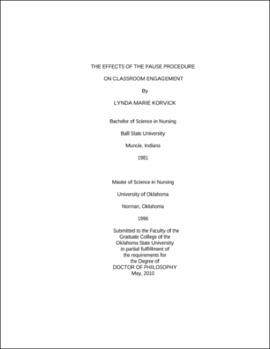| dc.contributor.advisor | Curry, John | |
| dc.contributor.author | Korvick, Lynda Marie | |
| dc.date.accessioned | 2013-11-26T08:34:38Z | |
| dc.date.available | 2013-11-26T08:34:38Z | |
| dc.date.issued | 2010-05 | |
| dc.identifier.uri | https://hdl.handle.net/11244/7468 | |
| dc.description.abstract | Scope and Method of Study: | |
| dc.description.abstract | The purpose of this study was to examine an instructional strategy intended to enhance engagement in the college classroom. The effects of the pause procedure on classroom engagement and cognitive load were studied. The relationships between levels of classroom engagement and near-term learning outcomes, as well as engagement and cognitive load were investigated in the Net Generation (Net Gen) students. The goal of this study was to empirically link the Net Gen to classroom engagement and cognitive load through the use of the pause procedure. | |
| dc.description.abstract | The study was implemented in a baccalaureate nursing program located at a small, private, liberal arts college in the Midwest. Pausing was introduced in three of six senior-level three hour weekly nursing class sessions. Near-term conceptual learning, engagement and mental effort, indicating cognitive load, were measured each class session. Statistical differences in engagement, conceptual learning and mental effort were measured between pause and non-pause class sessions. | |
| dc.description.abstract | Findings and Conclusions: | |
| dc.description.abstract | There was no significant difference in mental effort in any of the six class sessions indicating cognitive load remained stable throughout the study. A positive correlation was noted between the sole engagement factor and near-term learning. Other factors related to engagement remained unchanged with the implementation of the pausing in class. The pause procedure did not yield a statistically significant difference in near-term learning. The results of a mid-semester questionnaire indicated the vast majority of the students reported they preferred pausing in class. Senior level nursing students are considered advanced learners and the introduction of the pause procedure needs to be studied in lower level nursing classes. | |
| dc.format | application/pdf | |
| dc.language | en_US | |
| dc.rights | Copyright is held by the author who has granted the Oklahoma State University Library the non-exclusive right to share this material in its institutional repository. Contact Digital Library Services at lib-dls@okstate.edu or 405-744-9161 for the permission policy on the use, reproduction or distribution of this material. | |
| dc.title | Effects of the pause procedure on classroom engagement | |
| dc.contributor.committeeMember | Stansberry, Susan | |
| dc.contributor.committeeMember | Antonenko, Pavlo | |
| dc.contributor.committeeMember | Barney, David | |
| osu.filename | Korvick_okstate_0664D_10789.pdf | |
| osu.accesstype | Open Access | |
| dc.type.genre | Dissertation | |
| dc.type.material | Text | |
| dc.subject.keywords | active learning | |
| dc.subject.keywords | cognitive load | |
| dc.subject.keywords | engagement | |
| dc.subject.keywords | net gen | |
| dc.subject.keywords | note-taking | |
| dc.subject.keywords | pause procedure | |
| thesis.degree.discipline | Education | |
| thesis.degree.grantor | Oklahoma State University | |
